Tips and Techniques for Overseeding Lawns
The concept of overseeding lawns as part of a regular maintenance has been around for years, but it is still new to many homeowners. This one step will do more to improve the quality of your lawn than almost anything else you can do.
For the organic and conventional home turf experts, this is one of the best things you can do. Years of experience proves this. The information on this page will explain why overseeding your lawn is so important for a thick, healthy, and weed free lawn.
The two images below show the same fescue lawn before and after seeding. Overseeding was performed in early fall and was recommended due to thinning grass and increasing weed problems. The second image was taken the following spring after overseeding. The grass is thicker and the thin areas have filled in.
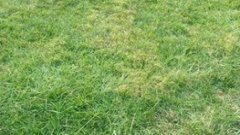
| 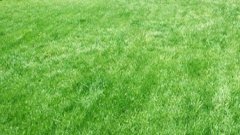 |
Grasses that Benefit From Overseeding
The practice of overseeding lawns is really nothing more than spreading grass seed over an existing lawn. The golf industry has been doing it since the sport began and is an important step in maintaining quality turf. Knowing how to do it correctly is the key. There is no need to invest in expensive equipment, just what is needed to do it correctly.
Not every grass type requires overseeding. The practice
of overseeding lawns is primarily reserved for cool season bunch type
grasses such as tall fescue, fine fescue, perennial and annual ryegrass and occasionally bluegrass.
There are exceptions, but for most home lawns, grass types that spread
by the production of "runners" are not generally overseeded unless it is
damaged or diseased. This includes most warm season grass varieties.
An exception is bermudagrass that is occasionally overseeded in the fall
using a cool season variety.
Understanding Grass Growth
Most cool season grasses are bunch type grasses. As the name sounds, they grow in a bunch, but growth habits are largely misunderstood. When lawn grass seed germinates, a single grass blade emerges. The grass crown, at the plant’s center, have roots growing down from the crown and the blades growing up. Grass plants expand as new grass blades, called tillers, develop and grow along side the original crown. Hundreds of new tillers can develop, each having its own crown, roots and blades. A blade of grass has a short lifespan of about 6 weeks and must continually produce new tillers or the grass thins out. If you would like a better understanding of how grasses grow, see the page on Photosynthesis.
Why is Overseeding lawns Necessary?
After several years, mature plants begin to slow down their reproduction rate. Since a blade of grass lives only an average of 45 to 60 days, production of new tillers must continually outpace the dieback of older leaves. Young grass will produce tillers faster than older grass. Therefore, one of the most important secrets to maintaining a healthy, thick lawn is to make sure your grass is young. (Nick Christians, PhD, Iowa State University) The practice of overseeding lawns is the easiest way of Keeping grass young.
When is the Right Time for Overseeding Lawns
Overseeding lawns consisting of Cool season grasses should be done in late summer or early fall. There are many reasons for this. With fall germination, the young grass will have two or three months to become better established before temperatures drop too low and growth stops. Next spring, the young plants will have another few months to develop deeper roots before the summer heat sets in. This is the primary reason, but there are also other reasons for overseeding lawns in the fall. Below are a few:
- Overseeding lawns in fall reduces or eliminates competition from summer weedy grasses, such as crabgrass, foxtails, and other weeds.
- Soil temperatures are still warm in the fall, which is necessary for seed germination, while the cooler air temperatures are better for grass growth.
- Rain amounts and soil moisture is generally better in the fall.
- Overseeding lawns in the fall gives the grass a head start. The roots have become established before winter, which greatly reduces crop loss should you have a hot, dry spring.
Methods Used for Overseeding lawns and Soil Preparation
Any method you choose to evenly distribute seed will work. The task of overseeding lawns doesn't require expensive equipment. Smaller areas can be done by using your hands if you do not have access to a fertilizer spreader. If overseeding lawns by hand, you should first divide the amount of seed you want to spread in half. Then carefully spread half of the seed by broadcasting it over the entire area. Choose a single direction to walk while spreading the seed. Then spread the other half of the seed at a right angle to the first direction you walked in. By broadcasting the seed in two different directions you have a greater chance of getting complete coverage.
Small hand-held rotary spreaders can also be used for small areas. They are generally inexpensive and are more precise than spreading by hand.
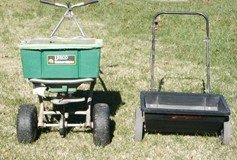
For larger areas, it is better to use a drop or rotary spreader. This is the same type of spreader that is used to spread lawn fertilizer. Drop spreaders, like the name sounds, drop seed directly below the spreader. The width of drop will never be wider than the spreader itself. Drop spreaders are more accurate when working around flower gardens or ponds, etc, but are not well suited for very large areas. Care must be taken to ensure you are walking in straight lines. Any swerve may result in a missed area. Overseeding lawns with a drop spreader is more work if the area is large.
I prefer a broadcast spreader for overseeding lawns. They come in various sizes from small push spreaders to larger commercial models capable of holding 100 plus pounds of seed. Depending on the spreader, you will get coverage 3 or 4 times the width of the spreader. Keep in mind that seed is very light and will not broadcast as far as fertilizer. You will need to watch carefully to make sure the seed is striking the disc at a consistent rate. If the openings in the bottom of the hopper are too small for the seed size, it could easily clog. If this happens, increase the size of the opening in the hopper and walk a little faster to compensate. Also, try to spread the seed when the air is calm. Overseeding lawns even with a small breeze is all that is needed to prevent an even spread.
Preparing the Grass and Soil for Overseeding
For seed to germinate it needs to come in contact with the soil. Seed will not germinate if it is resting on grass or grass clipping, leaves, moss, or any other material. It may help to mow your lawn to 2 inches or lower and collect the grass clippings. If grass clippings from previous mowings are covering the soil surface, you may need to rake the grass before applying seed. A metal rake is best, making sure the tines are scratching the soil surface. This will lift excess clipping or debris so the soil is exposed.
Core Aeration
Before overseeding is the perfect time to core aerate. Core aeration is the process of pulling out a plug of grass and soil approximately one half inch wide and three inches long. Walk behind, motorized core aerators are very heavy machines, some weighing several hundred pounds and take a little practice to use efficiently. Aerators can be rented at many equipment rental stores. Non-motorized, pull-behind types can be purchased at home and garden stores. Heavy watering or rain should precede aeration for effective core depth. Even the heaviest aerators have difficulty penetrating dry ground.
The removal of a plug during aeration relieves soil compaction, while increasing gas exchange and water availability to the roots. Two or three passes with the aerator in different directions is best. Don’t worry about picking up the plugs; they can be left on the surface to breakdown naturally. In a few weeks they will be gone.
Core aeration is not the same thing as spike aeration. Spike aerators do not pull a plug, but will simply punch a hole in the ground. On the down side it may slightly increase soil compaction, but at the same time helps air and moisture reach the roots.
Dethathing
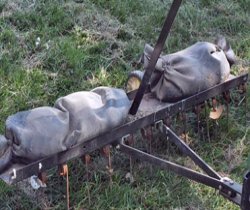
Raking is hard work, so another method is to use a pull-behind dethatcher. This is a device with dozens of metal tines that drag across the soil.
These models are designed to attach to the back of a
riding mower. The tray on top of the dethatcher can be weighted down
with sand bags or cinder blocks for deeper tine penetration into the
soil. I prefer sand bags instead of cinder blocks, since bags don't fall
off as easily. Tie them down if necessary.
To make you own bags, take a old car or truck tube and cut them into eighteen inch lengths. Use wire to close one end and fill the bag with sand or gravel. Wire the other end closed and you have a cheap weight that works great.
Make sure you use enough weight so the tines scratch at least an eighth of an inch deep into the soil. In dry weather you will need to water thoroughly before using the dethatcher. After going over the lawn several times in different directions use a mower with a bagging system to remove debris pulled up by the dethatcher.
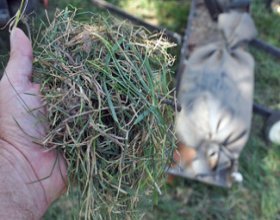
Keep in mind that dethaching will pull up a lot of dead and green grass. Grass clipping left on the lawn after mowing can form a thick mat. dethatching will remove much of this. The photo shows a fescue lawn and the amount of grass that is pulled up in just a few square inches of lawn. This does not hurt the grass.
Stoloniferous grasses, grass that spreads by runners, add another degree of difficulty in ensuring you are digging deep enough to remove thatch. Cutting through the stolons will not hurt the grass. The daughter plants along the stolon will continue to grow normally because they have their own root system.
Stoloniferous grasses are mostly associated with warm season grasses. Most cool season grasses, with the exception of rough bluegrass, do not produce a lot of stolons. The few that do produce stolons are fairly short.
You can also rent a motorized seeder for use in overseeding lawns. Seeders have several adjustable vertical blades that cut lines into the soil. Most have a built-in hopper that drops seed at the same time that it is making the cuts. The idea is that some of the seed will fall into the cuts, making good contact with the soil. The more expensive machines drop seed into the cuts and now where else. I have owned and used these machines and can tell you that seeders work best on flat and level ground that is relatively rock free. Flat and level means the ground has few holes, dips or mounds. The blades glide over dips without even scratching the surface, while digging deep groves into small mounds. Rocks will dull the blades quickly.
Choosing the Right Seed
Before overseeding a lawn, it is important to choose a seed that is compatible with your grass. You should try to use a seed that is the same as your grass. For example, if you have turf-type tall fescue, then use turf-type tall fescue seed or a blend of turf-type tall fescue seed and Kentucky bluegrass seed. Be careful about using bargain store seed brands for overseeding lawns. Bargain seed is often poor quality and can contain multiple undesirable varieties.
Overseeding Fescue Lawns
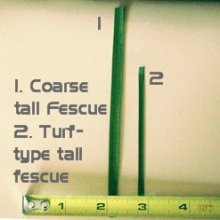
Fescue Rule: An important rule is if you have a turf-type tall fescue lawn, do not overseed with a coarse type tall fescue seed. Coarse fescue varieties, such as Kentucky 31 Tall Fescue or Alta are much larger plants having wider blades that were originally designed as pasture grass. They are often sold as lawn grass seed to those who do not know the difference. Stick with turf-type tall fescue if that is what you already have.
It is okay to combine bluegrass seed with turf-type tall fescue seed. Many professional seed blends use both because blades are similar in size and appearance and bluegrass spreads filling in gaps. However, the popular Kentucky bluegrass seed found in many seed bags is from an older variety of bluegrass that can’t take routine fertilization. It becomes very disease prone under high maintenance. If you fertilize regularly, ask to be sure it is an improved variety that can handle fertilization.
Important Note on Turf-Type Tall Fescue
If you want the best looking grass, be sure to use a turf type blend. The turf blends are the varieties that are being improved for appearance and deep green color as well as disease resistance qualities. If you choose a pasture grass, such as Kentucky 31, you are missing out on all the science and genetic improvements that will give you a much better looking lawn.
In addition, you get several different varieties in a single bag of turf-type so if one variety doesn't do well in your location or soil conditions, one of the others will. You don't get that with pasture fescue varieties.
Overseeding Lawns Using Fine Fescue Seed
Be careful when using fine fescue grass seed. The varieties of fine fescue in the U.S. are used primarily as a shade grass. It cannot survive in full sun except in places with year around cool climates. There are not many places like that in the U.S. For this reason it is marketed and sold as a shade grass. Varieties include creeping red fescue, chewings fescue, sheep fescue, and hard fescue. However, fine fescue varieties are often included in fescue seed blends because the grass will do well on shady sides of houses or under shade trees better than other grasses. Overseeding lawns using only fine fescue seed is not recommended, but is okay when combined with other seed varieties.
Overseeding Lawns with Bluegrass Seed
Most bluegrass species spread by underground stems called rhizomes. The most popular seed type is Kentucky Bluegrass seed. The rhizomes sprout at various points along the stem producing a new plant identical to the mother plant. Each new plant will send out rhizomes that produce even more plants. Because of the way it spreads, healthy bluegrass lawns rarely need overseeding. Bluegrass is often included in some tall fescue seed blends.
Keep in mind that Kentucky bluegrass can become disease prone if fertilized several times a year. It does well with infrequent fertilization. The improved varieties were designed to grow under more intense fertilization and are used by golf courses and well maintained home lawns.
Ryegrass Seed Mixtures
Lawns consisting solely of ryegrass are rare in the U.S. except in the transition zone. Ryegrass is usually combined with other seed types.
Perennial Ryegrass is popular in many seed mixtures, but is rarely used as a stand alone grass. It has poor cold and poor high heat tolerance. It is sometimes blended with fescue or used to overseed dormant bermudagrass lawns.
Annual ryegrass will only live for a year before it dies. Unless you desire a temporary grass, make sure you use a quality perennial ryegrass seed variety. Some lawn seed companies will blend annual ryegrass seed into the mixture because it germinates in only a few days providing a quick cover crop until the perennial varieties becomes established. Bargain ryegrass seed blends will often contain large amounts of annual ryegrass seed because of its low cost. It looks good for a while until it dies back leaving the home owner wondering what happened. It is better to spend a little more and get a higher quality seed blend.
Annual ryegrass is generally reserved for overseeding dormant warm season grasses or as a cover crop. This annual grass dies as the warm season grass starts emerging from dormancy in the spring. Annual grasses must be reseeded every year.
Overseeding Bermudagrass Lawns with Cool Season Grass Seed
Overseeding lawns containing Bermudagrass is common in the south. By using a cool season grass seed variety the lawns retains a green color throughout winter. Annual ryegrass, perennial ryegrass and turf-type tall fescue or bluegrass are often used. Do not use Kentucky 31 tall fescue or other coarse fescue blends for overseeding lawns. The coarse fescues are larger and taller growing plants that do not blend well in bermudagrass.
Establishing Warm season Grasses from Seed
Some varieties of warm season grasses can be established by seed. Soil preparation is the same for all grass seed. Be aware that seed of many varieties are much smaller than their cool season cousins, which makes spreading more difficult. If the seed is extremely small, mix the seed with at least an equal portion of sand. The amount of sand doesn't really matter, so use an amount that is easiest. For example, you can use one part seed to four parts sand. Measure out the amount of seed you need for the size of the area you are seeding. Mix the seed thoroughly with the sand, pour the mix into the spreader and evenly distribute the seed/sand mixture over your lawn.
If you are only wanting to fix thin areas in your lawn, correct the conditions that created the problems first. You may need to relieve soil compaction, fix water drainage problems, etc. Using sprigs or plugs to fix damaged areas will fill in faster than when using seed. For small damaged areas, use sprigs from your lawn and transplant in areas to be fixed.
Warm season grasses should be seeded or sprigged in the spring. Don't mix varieties, such as bermudagrass and zoysiagrass or centepedegrass and St. Augustinegrass, etc. Due to the way warm season grasses spread, they will try to complete with each other. They have different cold and heat tolerances as well. The more aggressive one will usually win.
How Much Seed To Apply
The amount needed for overseeding lawns are usually recorded on the label. It is different with different seed varieties. The rates can be adjusted depending on the thickness of your lawn. If you currently overseed on an annual basis, less seed is preferred.
- Use 2 to 4 lbs per 1000 sq. ft if your lawns is thick already. It is more of a maintenance activity for thicker lawns.
- When overseeding lawns with open dirt areas and other trouble spots, use 4 to 8 lbs per 1000 sq. ft.
- For complete renovation, 8 to 12 lbs per 1000 sq. ft. may be needed.
- Make sure you follow good irrigation techniques for the best results. It may take a couple of years, overseeding each year, for the lawn to look it best.
- Remember a key point when overseeding lawns: Try not to apply too much seed, and I emphasize "too much". Thick, vibrant lawns are created over time as plants grow and enlarge. Applying so much seed in an attempt get a super thick lawn in three months may lead to overcrowding as plants mature.
Golf courses often use 15 to 30 lbs of seed when overseeding important areas. Why? Because they have an extremely high user expectation. They don't have the luxury of "allowing it to grow in over time." They know how much of a particular seed the turf can handle. Don't try to follow their example or you may create problems for yourself.
Some websites will tell you to double or triple the recommended rates. Some even say when overseeding an established lawn that you should use double the rate of seed recommended for planting a brand new lawn. I don’t agree with this advice. They are assuming that the homeowner is not going to water correctly. The problem is if you do water correctly and get good germination, you can easily end up with to too much grass. Even if you use triple the rate, but fail to water, you can still lose the lawn. A lot of work is required for overseeding lawns correctly, so be determined to pay careful attention to how you water. You can measure out more seed if you really believe you need it.
Maintenance that Follows Overseeding
Keeping the Seeds Moist
After overseeding your lawn, the seeds will need moisture to germinate. Keep the soil moist (but not overly wet) by lightly sprinkling two to three times a day throughout the required germination period. Once your grass begins sprouting, you can cut down on the amount of water. Instead, water less frequently, but a little deeper. Be careful not to soak the soil repeatedly or you could encourage root rot diseases. As the grass grows, allow the soil to dry slightly before watering again. The greatest danger to seedlings is overwatering and soaking the soil, which could lead to disease (root rot) problems or underwatering and drying out the tiny roots. The second greatest problem is if you have high heat periods that cook the tender roots should the ground get too dry.
To Cover or Not to Cover Seeds
Generally when overseeding lawns, the existing grass provides cover and shade. In poor lawns with lots of exposed dirt, the soil will need to be raked to cover the seed with a thin layer of dirt.
If you plan to spread compost, apply the compost first and then seed. This is to make sure you don’t bury the seed too deep. After seeding, Rake the seed so the compost lightly covers the seed. There are also various seed coverings that shade the soil and reduce evaporation. The least expensive may be wheat straw. There is no magic to it, so just lightly spread a layer of straw over the lawn. With a light breeze you can use the wind to your advantage. The wind can catch the straw and distribute it evenly over ten feet or so. You will always get some wheat that germinates, but wheat can’t take repeated mowing. After a few cuttings, it will dieback and disappear. You may need to remove the straw after the grass starts growing if it was applied too thick.
Most professional turf mangers will spread seed after mowing and soil preparation. Some rake it in and some don’t, but it is always better to cover the seed with a thin layer of soil. Don’t mow again until the seed germinates and reaches at least two inches. It may take two to three weeks, depending on the seed type. If you mow before the seed germinates, you run the risk of picking up loose seed. Remember, contact with the soil and moisture is most important.
Using a Starter Fertilizer
When overseeding lawns, you may find it necessary to apply a starter fertilizer before or directly after seeding. This is especially true if a soil test says your soil Phosphorus (P) is low. Starter fertilizers will contain higher amounts of phosphorus (Middle number on the bag of fertilizer).
The reason for the increase is because phosphorus is relatively immovable in the soil. The soil may contain plenty of phosphorus already, but since it doesn’t move or leach, it may not be where the tiny roots can reach it. The only drawback to adding (P) is that weed seeds will benefit from the added phosphorus as well. However, when you remember that a thick turf is your best defense against weeds, added phosphorus will only help you achieve your goals. For a better understanding of how phosphorus and other nutrients works in plants, click on this link, Understanding the Soil Analysis Report.Tall Fescue Grass
Tall fescue is an exceptional cool season grass. It is preferred by
many because of its dark green color, wear resistance and heat
tolerance. Click here to find out everything you need to know about tall
fescue.
Kentucky Bluegrass
Kentucky bluegrass is one of the most popular of all cool season
grasses. It is used on lawns, fairways and athletic fields in the cooler
areas of the U.S. Find out what makes this grass so special.
Annual and Perennial Ryegrass
Ryegrass has come a long way with the introduction of new turf
species. See all the pros and cons about using the perennial and annual
varieties.
Introduction to Warm Season Grasses
Warm season grasses include Bermudagrass, Zoysiagrass,
Centipedegrass, St. Augustinegrass and others. Here is everything you
need to know about these grasses, tips and techniques, and maintenance
practices.
Watering a New Lawn
Watering a new lawn is very different from watering a mature lawn.
When planting a new lawn, success will be greatly increased by learning
proper watering techniques.
Lawn Winerization Tips and Techniques
Fall winterization is the most important time for fertilizing cool
season grasses. Warm season grasses do not receive the same treatment.
Find everything you need to know to winterize both cool and warm season
grasses.
Overseeding Lawns back to Lawn Care Academy Home
Share This page:
More Help in Creating a Beautiful Lawn
Understanding Grass Seed GerminationThis page answers the "Why" in "Why Do We Do It This Way"
Watering a New Lawn
Tips on correctly watering a new lawn. How to avoid common mistakes.
